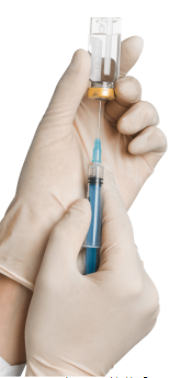Dealing with Mental Illness—It’s Not Easy
One in five teens experiences a severe mental health issue each year, according to the National Alliance on Mental Illness, most commonly depression, anxiety, or an eating disorder. These can be incredibly damaging to everyday life, but they can also be worked through–no matter how impossible it feels. In order to do so, one must first understand the issue and then build effective coping mechanisms, preferably with, if you have the means, a professional. The building blocks to begin such a journey, or to help another along the path, are available; it’s up to you to take them.
“It’s a biochemical disorder with a genetic component…where somebody can’t appreciate sunsets.” -Dr. Robert Sapolsky
Depression is often the first to come to mind when asked to name a mental illness, yet many people would not know how to describe what it actually feels like. Depression is often not just a sadness, but much more. It’s a lack of motivation, a feeling of worthlessness, a numbness. It can make you irritable and it can cause fatigue. It can even cause physical pains, such as back pain, stomach aches, and headaches. Depression can often affect a person’s ability to complete basic tasks.
One of the most effective explanations of depression came from Dr. Robert Sapolsky, a professor at Stanford University, who said, “It’s a biochemical disorder with a genetic component in the early experience influences where somebody can’t appreciate sunsets.” The final section about sunsets is in reference to a specific part of depression, which is the person’s inability to feel gratification or joy.
Depression is an incredibly hard problem to combat, partially because it takes away one’s motivation to be able to do things to combat it. That’s why it’s often helpful to build up a support system (or at least one very stubborn person) to force you to do things. If you cannot find the motivation within yourself to get out of bed and take care of yourself one morning, you may need someone to provide that motivation in whatever way they can provide it.
Dr. D’Elena, school psychologist, advises distracting yourself: “a little escape from the feelings or the moment. Often distractions come in the form of things you like to do. So, if it’s gaming, or reading a favorite type of novel, or watching a funny movie . . . something that brings on an opposite response,” he said. Find something that makes you happy in the face of sadness.
He also stressed the importance of self-soothing methods. As opposed to distraction, these are designed to help you handle the emotion rather than replace it. Examples of such actions would be taking a hot bath or shower, or going on a run.
If you have a depressed friend, Dr. D’Elena said that it’s very important you don’t allow them to lose contact. Don’t allow them to cut themselves off from the world. Work to bring them out of their shell.
Anxiety is not taken nearly as seriously as it should be by outsiders or by those who have anxiety. It is the most common mental illness in the U.S. and is highly treatable, and yet only 36.9 percent of people with anxiety receive treatment, according to the Anxiety and Depression Association of America. Anxiety is an umbrella term for a plethora of different disorders. While this term covers phobias, OCD, and PTSD, the focus in this article is going to be on panic disorder, generalized anxiety disorder, and social anxiety, as those are the more likely types of anxiety teenagers deal with.
Social anxiety, the most common of the disorders, is the intense fear of social situations in which one may embarrass themselves. They are often worried that they will do something that will be negatively viewed by others, leading to embarrassment, which often will cause a person with this disorder to avoid public areas or enclosed spaces. This can also cause problems in the average classroom setting; a person with this disorder gets anxiety not only over presentations, but also by called on in class or even having to say that they are present at the beginning of class.
Generalized anxiety disorder is more than just worrying. It is constant, excessive worrying about multiple issues even when there is little to no cause for concern. People with GAD may have an inability to relax, a tendency to jump to the worst conclusion, or difficulty concentrating or getting to sleep. Generalized anxiety can also cause physical symptoms such as shakiness or twitching, profuse sweating, breathlessness, or difficulty swallowing.

Finally, panic disorder is characterized by sudden and frequent panic attacks. Panic attacks are often emotionally along the lines of the feeling of completely losing control and being in imminent danger even when there is no threat present. The physical feeling of a panic attack is often compared to having a heart attack. They are incredibly harrowing experiences, and people with panic disorder will often try to avoid the place they had one. While understandable, this can often cause issues as they may begin to avoid work, the grocery store, or even driving.
When dealing with anxiety, it’s always good to keep basic de-stressing techniques under your belt. One commonly helpful technique is the 4-7-8 breathing technique: breathe in for four counts, hold your breath for seven counts, breathe out for eight counts.
Another suggestion to alleviate some of the anxiety is to eat breakfast. If you don’t have breakfast you can have low blood sugar, which can trigger states of anxiety. Removing caffeine from your diet can also help.
Dr. D’Elena advised those with social anxiety to push themselves to participate in activities that make them anxious. “When your mind or anxiety is telling you don’t approach or don’t be in a social situation, push yourself to do the little things. Rather than eat alone, go sit with people. Does it mean be the life of the party, or do all the talking in a conversation? No, but push yourself to at least be with the crowd,” he said.
“Does it mean be the life of the party, or do all the talking in a conversation? No, but push yourself to at least be with the crowd.” -Dr. Pete D’Elena
As for GAD, Dr. D’Elena said that much of the treatment is the same as that for depression. Self-soothing methods and distracting yourself are both recommended, but he also suggests self-talk. He defines self-talk as challenging any negative thoughts that come to mind, which is often difficult. The thoughts don’t have to end as overly positive, but instead change a ‘“everyone hates me” to a “some people don’t like me, but others think I’m perfectly okay.”
For panic attacks, Dr. D’Elena suggested that the first thing to do when you discover that you have panic attacks is to educate yourself on the subject. Understand that you are not going crazy, and you are not going to have a heart attack. Panic attacks will not physically hurt you.
As for helping a friend through a panic attack, one way is to fully remove them from the situation causing them issues. Taking them into a separate room, or just the corner of the current one, and having them put all their attention on you can often be beneficial. Do not stop this until they have fully calmed down or there is a heightened likelihood of relapse.
Lastly, there are eating disorders, a disease that kills someone every 62 minutes. According to the National Institute of Mental Health, 2.2 million people between the ages of 13 and 18 will experience an eating disorder each year, and yet only 30 percent seek treatment. The three most common eating disorders are bulimia nervosa, anorexia nervosa, and binge eating disorder.
Binge eating disorder is the most common eating disorder in the U.S., yet it is the least spoken about. To be diagnosed with the disorder, a certain number of criteria must be met. You must have recurring binge eating episodes, which is classified as eating more than the average person would in an amount of time, and feel a lack of control about what you eat. You may also eat more rapidly than normal, eat until uncomfortably full or eat when you’re not hungry; eat alone because you are embarrassed about how much you’re eating; and feel disgusted or guilty after eating. Binge eating disorder can often lead to obesity and other medical complications simply because of how much is eaten, but it isn’t necessary to be obese to be diagnosed with BED.
Anorexia nervosa, on the other hand, is often characterized by the person severely restricting food intake. This person has an intense fear of gaining weight and often has a distorted view of his or her own body. A person with anorexia will often see themselves as much larger than they actually are and become obsessed with getting to be the smallest they can be. They will skip meals and exercise excessively to the point of exhaustion. At a point, the body can no longer handle the lack of proper care and will take from the muscles, causing the person to become fatigued. They may feel dizzy or have bouts of fainting. At a certain point, a woman with anorexia may become so thin that she no longer has her period. For females 15 to 24, the death rate for anorexia is 12 times higher than any other cause of death.
Finally, bulimia nervosa is when a person will secretly binge food and then purge it in a variety of ways. They may force themselves to vomit, misuse laxatives, or misuse other medications or medical tools. Both the binging and purging is done privately, often with alternating feelings of shame and relief. Unlike people with anorexia, many people with bulimia are able to maintain a normal weight, even if their behind the scenes habits are unhealthy. Often people with bulimia will have decaying or damaged teeth from the constant exposure to stomach acids, intestinal distress from laxative abuse, or kidney problems from diuretic abuse. They will also often have severe dehydration issues from the purging of fluids from their bodies.
Eating disorders are multi-disciplinary issues. You’re unlikely to see one professional about it, but rather a therapist, a nutritionist, and possibly even a psychiatrist. Eating disorders are often very resistant to treatment and are difficult to overcome. The first step is to admit that you have a problem, and then talk about that problem to a professional.
When dealing with an eating disorder, people will often need a push to solve the problem. Others have to get involved. If you believe someone around you has an eating disorder, talk to them about it. Avoid being overly critical, as that will put your friend on the defense, and avoid using ‘you’ statements for the same reason. Choose a time where you won’t be interrupted, and be prepared for pushback. They may not realize they have a problem, or they may not want to solve it. Just remember that your friend needs you, and that you’re doing this because they are important to you.
Republished from Shoreham-Wading River’s print newspaper, The Wildcat Pause (April 2019 Issue).







